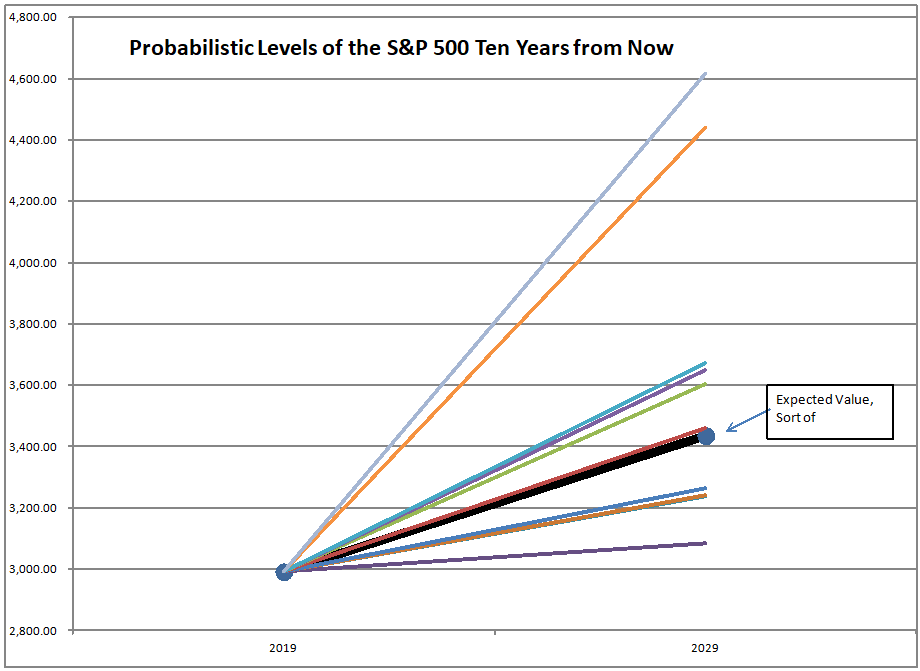Mmmm… it’s been 18 months since I did an update on this model. Here was the last one. The old article was written on 14 March 2018, and it said:
As it is today, the S&P 500 is priced to deliver returns of 3.24%/year not adjusted for inflation over the next ten years.? At 12/31/2017, that figure was 3.48%, as in the graph above.
https://alephblog.com/2018/03/14/estimating-future-stock-returns-december-2017-update/
And so now I say to you: As it is today, the S&P 500 is priced to deliver returns of 3.39%/year not adjusted for inflation over the next ten years.? At 6/30/2019, that figure was 3.61%, as in the graph above.
It’s fascinating how little changed over that period of time. SInce the last article, the S&P 500 returned 8.8% on a price basis with around 3% of dividends over the 18 month period. The ratio of their assets the US investors keep in stocks has also barely changed, going from 43,8% to 44,2%, (Geek note: the Fed’s estimate of that for prior periods shifts over time — today they estimate that ratio for 12/31/2017 to be 44.6%. This makes comparability of results and backtesting difficult.)
Using the ten scenarios from the past where the model was expecting returns between 2.39% and 4.39%, here’s what the results look like for the future on a probabilistic basis:

The ten scenarios came from the following years: 1968, 1969, 1997, 2001 and 2002. The high scenarios are 1997. The low scenarios come from 2001-2002.
My point forecast and the median value are close to each other. That is usually true.
So, should we be excited to earn 3.39%/yr for 10 years? Preserving capital would be a good thing, but many pension systems need a lot more than that. 3.39%. 3.39% is what an average low Single-A or High-BBB/Baa would yield in this environment.
Not knowing what inflation or deflation will be like, it would be difficult to tell whether the bond or stock would be riskier, even if I expected 3.39% from each on average. Given the large debts of our world, I lean to deflation, favoring the bond in this case.
Still, it’s a tough call because with forecast returns being so low, many entities will perversely go for the stocks because it gives them some chance of hitting their overly high return targets. If this is the case, there could be some more room to run for now, but with nasty falls after that. The stock market is a weighing machine ultimately, and it is impossible to change the total returns of the economy. Even if an entity takes more risk, the economy as a whole’s risk profile doesn’t change in the long run.
In the short run it can be different if strongly capitalized entities are taking less risk and and weakly capitalized entities are taking more risk — that’s usually bearish. Vice-versa is usually bullish.
Anyway, give this some thought. Maybe things have to be crazier to put in the top. At least in this situation, bonds and stocks are telling the same story, unlike 1987 or 2000, where bonds were more attractive. Now, alternatives are few.


Great post! I?d love to see this same data for other markets.
I would too, but I don’t know of any other countries that calculate net worth data and make it easily available.
why here arrive to different level? (around 7%)
https://demonetizedblog.com/2019/09/24/2q19-expected-returns-update/#respond
I made an offer to the writer to compare models. I’ve done this once before on this model, and we got the bugs out. I’m pretty certain that I am right, or, that he is running a different model in some way.
Hi David!
Followed the above link here. I must have missed your prior outreach to me somehow, but would love to compare the data we?ve used to estimate the model.
Couple possibilities jump out at me:
I had only estimated off data since the 1950s
Not sure if I?m using the same/?correct? Z.1 Balance sheet entries as I think some of the data sets have changed over time?
If you can confirm the exact data you are using to update, would love to troubleshoot the work I?ve done.
Also, glad to see you writing again as your blog was quite an inspiration to me!
I’ll send over my model to you a little later, and then we can see what we do differently. Talk to you soon.
David – welcome back. We certainly missed your cogent comments over the past year or more. However, for me one benefit of your “leave” was that instead of waiting for your quarterly update of this article, it forced me to build my own version and really understand what the model was doing. So thank you.
BTW – I am using the links to the data you provided and getting the same results as you, so I think demonetized is using different data.